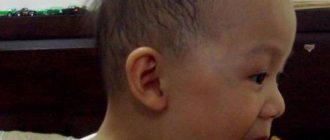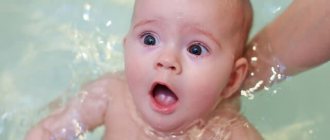The situation when a newborn (infant) child is afraid to bathe in the bathroom is an exception to the rule rather than the norm. Newborn babies are not afraid of water. For nine long months the baby “swimmed” in the amniotic fluid. Therefore, immersing yourself in warm water after birth, the baby finds himself in a familiar environment and experiences the pleasure of bathing. The child calms down, moves his legs and arms freely, and smiles. If a newborn shows what you think are signs of a fear of water, then this is not so, the newborn may simply be capricious. Do not confuse fear and whims. A fear of water can develop in older children, who begin to consciously understand everything and the reasons for the fear lie on the surface.
Reasons why children are afraid to swim
If a child experiences a “fear” of bathing from birth, then the reasons for this phenomenon most likely lie in an incorrectly organized first bath. Perhaps the water temperature was not comfortable for the baby (too cold or hot. Imagine the state of a child who was put into boiling water, naturally the second time the baby will feel fear... see about the correct water temperature for the first baths). Or the child could go underwater with his head and drink too much water, or experience unpleasant sensations if the shampoo got into his eyes. A newborn might be frightened by even the loud sound of water pouring from a tap and now associates unpleasant memories with bathing. Also, in order not to frighten the baby, from the first days try to create a calm atmosphere before bathing.
Read in detail - how to properly bathe a newborn
Watch the video: Baby's first bath
Another situation is when the baby at first happily took water treatments, and suddenly began to throw tantrums at the mere sight of the bathroom. If a child begins to be afraid to bathe several weeks or months after the first bath, then you have to understand the situation, analyze recent events, carefully observe the baby and try to understand why exactly the child began to be afraid of this.
The reasons may be either those listed above or others:
- ordinary fear;
- Uncomfortable water temperature (fear of getting burned);
- the child drank too much water (fear of gulping again);
- the baby does not like washing his hair (fear of feeling shampoo getting into his eyes);
- uncomfortable bath: the child always slips and slides into the water (we choose the right bath);
- the child slipped, fell and hit himself in the bathroom (fear of falling again);
- the baby had diaper rash and bathing hurt him;
- nervous environment (the reason, as you understand, is in the parents).
Safety regulations
To avoid your child’s fear of bathing in the future, follow the safety rules from the very first bath:
- The water temperature should be 36-37 oC;
- Purchase a special slide (chair) or bathtub with a fabric hammock for swimming. This device is necessary until the baby begins to sit confidently. It secures the baby well and allows the mother to cope with bathing without outside help;
- For bathing in a large bathtub, purchase a special rubber mat for the bottom of the bathtub to avoid slipping, falling and bruising;
- Wash your hair with special “no tears” baby shampoos; they do not cause eye irritation. It is enough to wash your hair with shampoo several times a week. We read a useful article about how to wash your child’s hair with pleasure: 7 surefire ways to persuade your baby to wash his hair without tears;
- Do not add hot water to the bath;
- Do not leave your baby unattended in the bathroom for a minute or with older children; a few seconds are enough for a baby to choke even in a small amount of water;
- Do not bathe your baby for too long so as not to overload the body. 5-10 minutes is enough;
We also read: what kind of water to bathe a child in (should I boil the water, should I add potassium permanganate)
What to do?
There are various ways to overcome your fear of swimming. You may have to try more than one or two until one of these methods works for your little one.
Method 1
In early childhood, babies very quickly forget their impressions (pleasant or negative), so the easiest way that can sometimes help is to take a break from bathing for several days. Unpleasant memories will be forgotten, and the baby will happily take water treatments again.
Method 2
Also, in very early childhood, a child often associates a room (bathroom) with further unpleasant actions for him. Sometimes a change of environment (moving bathing to another room) gives an unexpected result: the child behaves calmly and adequately in the new environment.
Method 3
Choose a moment for bathing when the baby is in a good mood. Take him in your arms and, talking tenderly, bring him to the water. Lower your baby into the bath, bending down with him so that the little one feels like you are bathing together. You can put a bright toy in your child’s hand for distraction. It may take you several days to overcome your fear. Do not be nervous. Act calmly. Soon the baby will relax and begin to enjoy the procedure.
Method 4
Another good method for overcoming the fear of water is to take the baby together with mom or dad. Before this, an adult needs to take a hygienic shower. Being in close contact with an adult, the baby feels completely safe and calms down.
Read also…. How to properly cut a child’s toenails, hands, when to cut a newborn’s nails
Method 5
This option is suitable for children who are already sitting confidently. You need to pour a small amount of water into the basin and put various toys (rubber animals, plastic fish, boats, watering cans). Play with your baby, show him how it “rains” from a watering can, how fish, ducks and frogs joyfully splash. Children at this age enjoy playing such games. After some time, the game needs to be moved to a large bathtub. DETAILS: Bathing toys for children under one year old
Method 6
For older children. There are times when a child enters the bathtub, stands in the water, but is afraid to sit down and plunge into the water. Ask, while playing with the baby: “Shall we pour some water up to the knees or a little more?” There is no need to rush, stop at the achievement that you have achieved today and, step by step, overcome your child’s fear of water. Another option, try blowing soap bubbles. The baby will be distracted from his fear and, perhaps, playing with bubbles, will sit in the water.
Fear of big water
I will describe a picture that is familiar to everyone. Summer, sun, river bank (sea, lake, pool). Everything is wonderful... And suddenly a heart-rending child’s cry: “Ah-ah-ah!” These are kind adults trying to bring happiness to their baby - to drag him into the water. Please don't do this, loving moms and dads. Stock up on an inflatable pool, a water bucket, beads and other useful children's beach accessories. The child is gradually accustomed to water and to a new environment: to get used to new tactile sensations from the breeze, sand, and pebbles.
Let the baby’s first “sea” be a small inflatable one. Together with your child, fill the pool with a bucket; do not force the child to go to such a depth that you think is not scary. Everything has its time. When the child is ready, he himself will drag you into the water, but for now enjoy the fact that he is constantly in sight, and you should not stand on the shore in a position “under the visor”, not taking your eyes off the child.
How to properly bathe newborn babies
The following rules for parents will help to achieve maximum physical and mental comfort in the bath:
- The water temperature for swimming should be between 36–37°C. Check the degree of heating with a special water thermometer. Forget about grandma's methods - elbow, palm - an adult's skin sensitivity is much lower than that of a newborn.
- Fill the baby bath with enough water so that it does not cover the baby's head after immersion. Shoulders, knees, and tummy can be above the water. Wash these parts of the body from your palm.
- For the first time, bathe your baby in a diaper or place it on the bottom of the bathtub. The newborn should feel not a slippery bottom, but soft, pleasant support.
- Prepare your baby for bathing. Don't make sudden movements. Bring the baby to the water, wet the legs, arms, and a little face.
- Dip the baby into the water, starting from the feet.
- Hold the head firmly.
- Don't splash in your face.
- Use your palm to pour water onto the body, gently stroking the baby.
- You can make a couple of rocking movements in the bath. Let the baby feel free and have fun.
- Take a bath for no more than 5 minutes. This time is quite enough to wash a newborn.
- Wrap your baby in a towel in the bathroom or other warm room. If the baby gets cold, he will cry the next time after bathing, fearing a repeat of the situation.
- After treating the navel, applying cream to the body, dressing or swaddling, feed the baby.
This is interesting! Newborns are very receptive to music. Play a soothing, quiet song while you bathe. The baby will relax and get used to the music in the bathroom. This will help cope with fears and psychological stress.
Three rules without which it is impossible to learn to swim.
A person is forced to learn how to swim in the same way as to walk. Therefore, as soon as the little one is born, try to create all the conditions for him to master swimming skills. Remember that every person is different. Some people learn quickly, while others spend more time and effort on it.
On topic: Children's self-esteem
There are 3 main stages through which it is possible to master this skill:
1. Feeling of self.
Water is a completely different element. You need to learn to feel it. And for this you need to immerse yourself in it. Choose a shallow pond with a flat bottom for training to avoid fear at depth. Ideal, of course, to study in the pool. You should not use inflatable vests and armbands. The child should, first of all, get to know his body in a new environment. Ask him to simply walk along the bottom. When you get comfortable, add jumping and running. As soon as it reaches a comfortable state, you can begin to turn the body left and right.
2. Breathing.
To be able to exhale correctly during a dive, you must first learn how to do it in the air.
Take some water into two palms and bring it to the baby’s face. Let him blow it away. Or he kicks a light ball with a strong and sharp exhalation. Thus, he will understand the very principle of operation. It is better to work through both the nose and mouth at the same time. It will turn out more freely and naturally.
The next stage is to dive, making the same exhalations. You can use the jump. Jumping up, we took in air, while diving, we exhaled. If the baby is anxious and worried, you can hold him by the arms so that there is support.
Baba sowed peas (jump up)
And she said to her grandfather - Oh! (immersing)
It is advisable to perform as many such inhalations and exhalations as possible.
3. Movement in water.
When the baby gets used to the situation and learns to exhale, you can ask him to perform absolutely any figure, depending on your and his imagination. It could be a float, a star, etc.
You can lean on a side or other support and dangle your legs. Do not forget that any action is performed by the young swimmer when he feels the bottom. Let him walk, jump and run around it to his heart's content.
On topic: How to potty train a child.
One of the exercises for mastering and holding your breath is the arrow! We extend our two arms and connect them above our heads by placing one palm on the other, push off with our feet and swim, creating a slide on the surface.
Be sure to praise your little student.
He must want to, learn himself, pull you to swim!
I wish you success!
Dear readers! If you liked this article, share it on social networks. This will be your best “thank you” for the material.
Did you like the article? Share with your friends!
Why is a child under one year afraid of water?
By the age of 6 months, infants already understand a lot, are able to consciously express dissatisfaction with what is happening around them, the joy of communicating with loved ones, and the desire to carry out one or another hygiene procedure. If your baby bathed without fear during the newborn period, and by six months he began to be afraid and resist going to the bathroom, then the reason for this behavior may be:
- Injuries, bruises while swimming. By 6–7 months, babies become much more mobile and difficult to hold. They want to sit and reach for bright objects. Restlessness often causes falls and slipping during washing.
- The kid didn't like washing his hair with shampoo; he tasted the soap. Foam could get into the eyes, mouth, and the unpleasant sensations were remembered.
- The little one choked. Water gets into the mouth due to splashes from the hands or carelessness of the mother when rinsing the baby from the ladle.
- My ears hurt after a bath. Liquid gets into the ear when a child dips his head in water and tumbles.
- The baby was frightened by the drain, pressure, and temperature of the water. An unexpected encounter with the unknown does not always bring joy to kids. Loud sounds, touching hot or cold things often frighten.
- Emotional incontinence of parents. Screaming, scolding a tired, irritated mother for doing something wrong in the bath, frisky games with water give the washing process a negative connotation.
Children under the age of one year are sensitive; praise, smiles, and close contact with their parents are important to them. A calm environment, a positive and playful attitude in the bathroom when bathing will help you overcome fear.
Important! Kids quickly forget momentary fears. Try not to let fear become a habit; don’t scold him for crying. Create a comfortable environment and the fear will go away.
We recommend watching this video, from which you will learn about the reasons and methods of dealing with a child’s fear of water:
SHAKEDOWN CRUISE
In order to be sure that your child will cope with himself and will be able to take up swimming, you can attend a trial swimming lesson with us.
An experienced instructor will be at the lesson, and you will be able to understand whether the baby is ready to perceive water as his native element. You can sign up for swimming either through the form on the website, or by phone, or via chat.
If your child’s fears of water persist, seek help from a child psychologist. It is important to know that phobias can be a symptom of other disorders for which the child will need professional help, for example, phobias can signal attention deficit hypermobility disorder.
Causes of fear of water in children after 1 year
It is during this period that children often begin to be afraid of water and bathing. Fears that arise at 1-2-3 years old easily turn into phobias and interfere with adulthood. It is extremely important to overcome the problem as quickly as possible by understanding the reasons for its occurrence.
There are several factors that provoke hydrophobia, characteristic of children from 1 year to 3 years:
- The kid categorically did not want to wash himself, but they forced him, shouted at him for being stubborn, and punished him.
- The baby fell and slipped on the floor in the bathroom, in the bathtub itself.
- A one-year-old baby was left to swim alone.
- The baby drowned in the home bath, in the pool, in the sea. In this case, there is a fear of drowning—hydrophobia.
- The washing procedure is unpleasant due to caustic soap and shampoo.
- The child is afraid to wash his hair or rub his body with a washcloth.
- There is too much water or not enough water in the bath.
Three-year-old babies are good manipulators. If you see that the reluctance to wash or enter the water is a whim, then do not pay attention to this behavior. If there is a reason for fear, eliminate it. Below we will tell you how to help your child overcome fear and get rid of aquaphobia.
Causes of fear of water in newborns
Children rarely develop a fear of water immediately after birth. In the womb, the fetus is constantly in the amniotic fluid; this is its usual environment.
But if you still have fear, you need to pay attention to the following points when swimming:
- The temperature of the water in the bath is unpleasant for the baby. The child could get a thermal burn from too cold or hot water.
- The baby is suddenly suddenly plunged into the bath. Contact with water occurs unexpectedly. The consequence is fear.
- Large bathtub. The baby feels in danger, is terrified of space, of being in a position without solid support.
- The baby has a rash on his body and his skin itches. When bathing, irritated areas tingle.
- Parents get nervous while washing their baby. The tension is transferred to the child.
Newborn babies quickly forget fears and unpleasant experiences about going to the bath if the situation does not repeat itself. Follow pediatricians' advice on how to properly bathe babies, and the phobia will quickly pass.
How much does your child dislike bathing?
How to deal with your fear of water
When choosing a method of dealing with a phobia, parents should take into account the age of the child and try to find out where the fear came from. Use different methods to achieve a positive result.
Read also…. A child falls out of bed in his sleep. How to protect a baby from falling?
Advice from psychologists
For children of any age, the psycho-emotional atmosphere in the home and relationships with parents are very important. Warmth and understanding help to overcome fears and prevent their occurrence. To get rid of hydrophobia, follow a few tips from psychotherapists and pediatricians.
What not to do if a child is afraid or does not like to swim
- Force you to take a bath, enter a river, a swimming pool, or the sea.
- Yelling while bathing or washing.
- Hurry.
- Immerse your body in water abruptly.
- Accustom to hardening immediately in cold water.
- Leave him alone to swim in a pond.
- Draw a full bath.
- Scare the baby with a shower or strong pressure.
- Splash water in the face, especially for children from birth to one year.
- Carry the child into a cold room after a warm bath.
- Rub the clean body with a hard towel.
- Use rough washcloths.
How to help your baby cope with hydrophobia
- Show by your own example that water is a source of joy, fun, and purity. Teach your baby to love bathing. While washing, talk about how a person cannot exist without water, play, splash. Add more positive emotions to the process.
- Play with water in your free time. Place the basin on the floor, put cups and rubber toys in it. Let the child splash and douse himself. This way he will understand that the water is safe.
- Turn bath time into a game. Bring more toys, ducks, boats. Wash your baby gradually while he is busy.
- Try changing your baby's bathtub. Perhaps the container is too deep, large or, conversely, too tight for the baby.
- Before washing, tell your child what you will do now. Set your baby in a positive mood.
- Be sure to praise after a successful bath. Positive assessment and parental support are very important for children.
- Talk to children 2–3 years old about the need for hygiene procedures and their safety.
- Don't insist on washing if your little one is in a pose today. Skip the hygiene procedure, take a 2-3 day break.
- Wash your child in his pajamas if he doesn't want to do it naked. Get rid of clothes gradually next time. You can remove one item every day for a week.
- Take a swimming course with your babies. The instructor will teach the child to swim and allow him to dive. The baby will see other children and their reaction to water.
- Change the environment, room. Go to your grandmothers and friends on a bath day. Perhaps the reason lies in a negative attitude towards your bathroom. As a last resort, you can wash yourself in a basin in the kitchen.
- Do not bathe a fearful baby in a bad mood, choose the right moment and gently carry out the procedure.
- Wash your babies together. The child will feel safe, and wallowing with dad or mom is much more fun.
- When washing newborns, lean over the bathtub as deeply as possible. The baby will think that you are in the water with him. The neck and head must be clearly held in the air.
- Touch the water before immersing yourself in the bath. Let the baby wet his palm, then his arm to the elbow, his heel, and so on. Stop at the stage when the baby becomes scared.
- Replace washing in a container with a shower or dousing.
- Allow them to do things when bathing that are usually prohibited. For example, drawing on the walls. Gouache and watercolor can be easily erased from the tile, and the child will receive a lot of pleasant emotions.
- Add affection and love to your voice. The baby will feel your care and tenderness. Persuade him to wash only with this intonation, forget about shouting and threats.
- Talk to your baby while he is washing himself. The baby will take his mind off the water and enjoy communicating with his mother.
Important! If fear turns into a phobia, and any contact with water cannot be avoided without hysterics, do not hesitate to consult a doctor, preferably a psychologist or psychotherapist. Early treatment of fear and timely consultation will save the child from problems in the future.
Here are some more interesting tips from a child psychologist on what to do if your child doesn’t like to swim:
Advice from experienced parents
- For 4-6 month old babies, buy a special bathing ring. It is put on the neck, the child feels calm and free. And mom’s hands are not busy.
- Don't skimp on a slide or a seat for bathing children after 6 months. They will protect the bathing process; the baby will not be able to swallow water, roll over, or slip.
- To prevent injuries, place rugs on the floor and in the bathtub.
- Use dry bathing. Play with a bath without water. Cover the bottom with a diaper, put the baby there or sit an older child. Let him get used to the new subject. Gradually add water to it.
- Place your baby in the bath before the water fills. Let him watch the container fill. Give your child toys. While the water fills up, he will play out and forget that he was afraid.
- Use special shampoos and shower gels labeled “No Tears.” They are easy to wash out of the hair, they do not irritate, and do not pinch the mucous membrane.
- There is no need to soap your face; wash your eyes and nose with clean water.
- When washing your hair and rinsing your hair, tilt your neck back slightly. The water will flow down the back of the head, the foam will not get into the eyes.
- Use open bodies of water to communicate with the water. A river, sea, or lake can become favorite vacation spots in the summer. It is not necessary to dive right away; you can walk in the water with your bare feet, swim near the shore, going up to your waist.
- Make up your own bathroom game. For example, a dolphin. The baby will be a curious and brave waterfowl, and you will be an observer. Praise the hero for courageous actions, diving and floundering.
- A continuation of the role-playing game can be an instructive tale. Tell your son or daughter about how the dolphin was afraid of water, and then overcame his fear, accomplished a feat and was the pride of his parents. A fairy tale will teach you not to be afraid and will become an example for a coward.
- Learn poems and jokes about water. Tell them while bathing, during daytime games in the room.
- Blow soap bubbles through the water. The child will want to catch them, but to do this he will have to go into the water.
- Create an appropriate interior in the bathroom. Hang pictures, bright towels, Velcro, suction cup toys. The child should want to go there and touch the fairy-tale objects.
- Change the word "swimming" to something else. Perhaps it is this very concept that frightens the baby. Say: “swim”, “flounder”.
Read also…. Not for a child from 1 to 3 years old: how to do it correctly.
Hydrophobia cannot be ignored at any age. Without bathing, washing, swimming, human life is impossible. Help your child get rid of fears, forget fear, stress, and fall in love with water. This will have a positive effect on his physical and mental health.
The game is a great helper in combating any fears of children. Try to play with your baby in the bath as much as possible, throw a lot of different water toys into the bath, entertain the child, talk to him, tell him that the toys are not afraid of water, how fun they splash, play and are not at all afraid of water - and then the bathing procedure will be associated only with fun. Will the child forget what the fear of bathing is?
Children from 1.5 to 5 years old are often afraid of bathing in the bathroom. And if an infant can scream in the bathtub while bathing from a banal fear of water and unfamiliar surroundings, then a baby over 1-1.5 years old is afraid of water because of fear. Why is a child afraid to swim? Why does he panic when he sees the bathroom? Let's find answers to these and other questions together!
How to overcome your fear of taking a bath
- Remove restrictions. If you use a safety seat when washing your child in the bath, then the baby is most likely protesting against the restriction of movement, and not against the bath itself. Let it flop and splash freely. It will become more difficult for you to bathe your child, but he will not refuse to wash himself. Make sure your newfound freedom is safe.
- Let there be bubbles. As well as non-toxic soap suds and dyes. By the way, check that the soap you use does not irritate the skin, especially if you have a girl. It is better to use baby soap foam. Have a flotilla of plastic boats floating in the bathtub, along with funnels, cups and any other items suitable for water fun. The baby, sitting in the bath, will focus on playing, and not on washing. Don't announce: "It's time to swim." It’s better to invite him like this: “Look at the bubbles! Come on, can boats get through them?” or “Come on, let’s paint tiger stripes on you with this bright soap!”
- Change your schedule. If the baby is invited to the bath unexpectedly, and not at the usual time, he is unlikely to particularly protest, for example, if bathing is postponed from the evening to the morning. True, in this case the child will not wash when he is dirty, but it is better than not washing at all. When he becomes more relaxed about bathing, you can reschedule this procedure for the evening, but in the meantime, quickly dry him with a wet towel before changing into pajamas.
- Keep some company. Bathing can be more enjoyable if there is someone else in the bath. Mom or Dad is best. If you don't feel comfortable being naked in front of your baby, wear a swimsuit (remember that the water temperature should be appropriate for your baby). It’s good if a brother, sister or playmate swims with the baby (of course, with the permission of his parents). The pleasure another person feels from washing will almost certainly be passed on to the baby.
- Take a shower. If your baby protests against the bath, wash with him in the shower. A special visor will protect the child’s eyes from water and prevent him from perceiving the falling stream as a threat. Adjust the shower to the lowest water pressure. You will probably have to hold your baby until he gets used to it and wants to stand in the shower on his own. While washing, it’s good to hum some song about rain. Please also note that the water, like in a bath, should be warm, not hot.
- Admit yourself defeated. If all your attempts to lure your child into the bath are unsuccessful, do not resort to forceful methods. This can lead to mental trauma and cause him to have a persistent aversion to washing. It’s better to forget about bathing for a while, replacing it with wiping with a damp mitten and then with a towel.
Fear of swimming: let's look at the reasons
If the baby begins to be afraid of water, what happens most often is that the parents organize the bathing process incorrectly:
- the child is left unattended in the bathroom;
- the baby “drinks” water while bathing due to the fact that the parents carelessly water it from a cup or shower head;
- the child is afraid to swim because the parents do not check the temperature of the water, as a result of which he splashes in too hot liquid;
- while bathing, a one-year-old baby encountered such an unpleasant phenomenon as shampoo or shower gel stinging his eyes;
- The baby was frightened by a loud sound or a strong aroma while bathing, so now the bathroom evokes negative emotions in him;
- The baby is afraid of the cold or diaper rash that may occur after taking a bath.
The influence of a TV or tablet should also not be overlooked. For example, a child watched a video on TV in which a child was crying in the bathroom or was afraid to take a shower. For a fragile child’s psyche, such a video will be enough!
Important! Also, the reason that a child is afraid to swim can be an uncomfortable bath, in which the baby slides under the water or simply feels uncomfortable.
Bathroom safety precautions
These simple precautions will help you properly organize the bathing process and make it completely safe for your little one:
- Always make sure that the water temperature in the bathroom is comfortable for the child and does not exceed 37 degrees.
- Ask a person whom the baby especially trusts to be present during bathing: dad, grandma, grandpa, brother or sister.
- Buy an interesting set of toys specifically for the bathroom. It should be fixed in the child’s mind: washing is a fun and exciting process.
- Place a special anti-slip mat on the bottom of the bathtub.
- Use only high-quality detergents labeled “anti-tear.” They should not have an intense odor or color. A good product should be transparent with a neutral aroma and delicate texture.
Be a little persistent, gentle and patient.
Believe me, one day your love and patience will bear fruit: the baby will completely overcome all fears and will again splash in the water with great joy.
The child is 1 year old and he is afraid to swim: what to do?
If your baby has crossed the one-year mark and has begun to be afraid of bathing, then you should look for the reason in the incorrect organization of the bathing process. You can try to correct the situation by following the recommendations below:
- purchase special chairs, slides or anti-slip mats, thanks to which the baby will feel protected in the water;
- check the water temperature using modern thermometers;
- never leave your baby in the water without adult supervision;
- use “tear-free” shampoos and gels;
- use soft towels that do not injure the skin;
- Try to bathe your baby for no more than 5-10 minutes.
Advice! Order the installation of a handrail in the bathroom for children who are 2-3 years old. The child will be able to hold on to such handrails during water procedures, which will reduce the level of fear.
If the above recommendations did not help and the child is afraid to swim, then we will try other methods recommended by experienced mothers and pediatricians.
Method number 1. Swim with your child
If a child was afraid of water, then at a certain moment he did not feel the support of his mother or father. Therefore, it is worth starting to swim with your baby, after dressing in a bathing suit and taking a shower. With mom or dad, the child will feel more relaxed in the water, and he will also learn to play and swim.
Important! Swim with your baby no more than 2-5 times, after which let your baby frolic in the water on his own while being close to him.
Tip #2. Get your child interested
There are dozens of options for bath toys lined up on store shelves: ducks that shoot water, protective circles for swimming that prevent the baby from going under water, slides that make water procedures even more fun. Be sure to purchase toys and protective equipment that will allow your baby to feel free in the water and help him accept bathing as an exciting game!
Tip #3. Teach your baby to play with water
If your child is afraid to swim, get him interested and show him that the water is absolutely safe. In a well-warmed room, place a basin or pan with water, covering the floor with oilcloth, and then invite the child to play with toys. The baby will happily splash around and realize that bathing involves not only washing his hair, but also an exciting game.
Tip #4. Gradual filling of the bathroom
The child is afraid of depth, so put him in the bathtub, and then gradually fill it by pouring the crumbs from a cup or ladle. The baby will get used to the rising water level, and being near mom or dad will strengthen his confidence in his own abilities.
Tips and techniques for overcoming fear
| Method name | How does it work? | How to organize it correctly? |
| Distract with games | Playing while bathing helps the child forget about his fear and switch to other interesting things or activities. |
It is worth noting: the distraction method works very effectively, which is why psychologists practice it often. And not only to combat children’s fears, but also when it is necessary to establish a constructive dialogue with the child, to relieve him of anxiety. |
| Leave the baby for several days without washing | Sometimes a temporary refusal to bathe works very well for children. Babies do not know how to think several days ahead and very quickly forget that they were once afraid of bathing. Having forgotten his fear, the baby perceives the washing procedure as a completely new activity for himself and bathes with great pleasure. |
|
| Changing intonation | A new intonation in a parent’s voice will give the effect of novelty and will interest a two or three year old child. | Try changing the way you talk to your child if bath time is planned. Speak to him quietly and kindly, offer to touch some water from the tap, let him touch it with your palm . This manner of behavior on the part of mom or dad will surprise the child and gradually develop a trusting attitude towards water procedures. |
| We play “the whale and the inhabitants of the ocean” | Children love to imagine themselves as animals or mythical creatures. Invite your child to play the role of a little whale who lives in the river or sea and really wants to return home for a while. |
|
| Let's practice swimming together | A child often feels safe next to his parents. Start swimming together to help your child relax and regain confidence in the water. | Take a shower, bath together, play while bathing and do common things. You can water each other with a watering can, blow bubbles, splash around - the main thing is that the baby sees you nearby and feels supported every second of his stay in the bathroom. |
| Visiting an open pond | This method is suitable for those who have a river, sea or lake nearby. In open spaces where there is a lot of water, the child gradually begins to perceive it differently and gradually learns not to be afraid to swim and bathe. |
|
All of these methods are effective in one way or another, however, every child is unique.
It may well happen that none of the above methods will suit him personally. In this case, it is better to go for a consultation with a child psychologist and solve the problem with the help of a specialist.
The main thing is to be patient.
Fear of bodies of water
In addition to bathing, hydrophobia can occur in a pool or when trying to swim in a large body of water. In such cases, there is no need to put pressure on the child and forcefully drag him into the water. Moreover, you cannot laugh at his fears and show that they are not taken seriously. It is best to give him time to get used to it himself, showing by example what a pleasure it is. You can wet the baby’s feet, splash water on him while playing, or water him from a watering can. Most likely, after a while the baby will get used to it and, looking at the adults and children splashing happily, will go into the water.
If parents are faced with the fact that their child has become afraid of water, they should make efforts to help him cope with this. Feeling the calm confidence of the parents, it will be easier for the baby to feel protected and overcome his fears.











